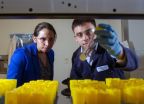(Press-News.org) DALLAS – March 26, 2014 – "Today, we're going to make history," said 18-year-old Eric Ramos on the day UT Southwestern Medical Center doctors operated on his ailing heart. Eric, who has Duchenne muscular dystrophy, is one of only three patients in the United States with the condition to receive a battery-operated left ventricular assist device (LVAD) to keep his weakening heart pumping blood through his body. He is the first patient in the country to be given a specific, smaller LVAD, which means doctors would not need to manipulate his diaphragm, which could compromise his already limited pulmonary function.
Duchenne muscular dystrophy, a recessive X-linked form of the disease, affects around 1 in 3,600 boys. Diagnosed at age 6, Eric has used a wheelchair for the past seven years because his muscles, including his heart and lungs, are rapidly degenerating. Nevertheless, Eric has the heart of a champion. He views his latest challenge as an "unreal accomplishment" and says he is honored to be part of history, paving the way for other Duchenne patients with advanced heart failure.
Lead surgeon Dr. Dan Meyer, Professor of Cardio Thoracic Surgery and Director of Mechanical Assist Devices, says it took a team to pull Eric through this historic feat. "We had cardiologists, cardiothoracic surgeons, LVAD coordinators, neurologists, pulmonologists, social workers, nutritionists, and a host of nurses and others excited to be a part of this unique opportunity," Dr. Meyer said. "Delivering advanced medical care to patients like Eric is something you can only do at an institution like UT Southwestern, where we have the experience and the specialized care to perform higher-risk surgeries that other hospitals would not even entertain."
The decision to operate, however, was not easy. The team members recognized the severity of the situation, but they were put at ease the moment they met Eric. A senior in high school, Eric spends his free time playing video games, tinkering with computers, and hanging out with his friends, just like most teenage boys. But Eric exudes maturity well beyond his years.
"We could see that Eric is a vibrant young man, despite the fact that he is bound to a wheelchair," Dr. Meyer said. "The tough part was making sure we would increase his quality of life and that undergoing surgery was worth the risks."
Because of his faith, Eric says he was cool, calm, and collected the day of his surgery. "Hope canceled out my anxiety and fear," Eric said. "I knew that I was making history, and that one day people were going to read about my case, and to me, it felt good to be a trailblazer."
Another person in Eric's corner is Dr. Pradeep Mammen, Associate Professor of Internal Medicine in the division of cardiology and Medical Director of the Neuromuscular Cardiomyopathy Clinic at UT Southwestern.
Dr. Mammen is one of Eric's biggest advocates. A heart failure/transplant cardiologist with special expertise in the cardiovascular complications that can occur in patients with neuromuscular disorders, Dr. Mammen spent countless hours conducting background research on all the key components needed to ensure Eric would thrive pre- and post-LVAD implantation.
"For me, working with Eric and advocating on his behalf has been one of the highlights of my career," Dr. Mammen said. "This is a paradigm shift in how we approach the treatment of Duchenne muscular dystrophy patients, as well as patients with other forms of muscular dystrophy. We clearly have moved the field forward in terms of how we treat patients with muscular dystrophy and subsequent heart failure."
To Dr. Mammen, Eric is proof of the principle that LVADs can help prolong the lives of muscular dystrophy patients. "This procedure has to be done for the right patient, by the right team," Dr. Mammen said. "Our team flawlessly executed this endeavor for Eric."
Eric is happy to have a team of health care professionals working hard to make his life better and, of course, for the support of his family and friends at home in Rowlett, Texas.
Today, when Eric looks in the mirror, he says it is "thrilling to see the torque of the pump pushing blood through my body. My whole body pulsates." He likens this to the body's response when a sports car accelerates. Eric looks forward to a bright future, including graduating from high school this spring, and he hopes someday to receive a healthy heart via transplantation.
UT Southwestern has played an integral role throughout the relatively short history of LVAD therapy and in the devices' rapidly evolving technology. UT Southwestern participated in the landmark clinical trial (REMATCH) that led to FDA approval of the first LVAD for destination therapy and was the only North Texas center to participate in the HeartWare Bridge-to-Transplant trial, which was completed in 2012 and led to FDA approval of the device.
INFORMATION:
To obtain more information on clinical trials and treatments for advanced heart failure at UT Southwestern, contact the University Hospital Heart and Lung Clinic at 214-645-5505.
About UT Southwestern Medical Center
UT Southwestern, one of the premier academic medical centers in the nation, integrates pioneering biomedical research with exceptional clinical care and education. The institution's faculty includes many distinguished members, including five who have been awarded Nobel Prizes since 1985. Numbering more than 2,700, the faculty is responsible for groundbreaking medical advances and is committed to translating science-driven research quickly to new clinical treatments. UT Southwestern physicians provide medical care in 40 specialties to nearly 91,000 hospitalized patients and oversee more than 2 million outpatient visits a year.
This news release is available on our home page at http://www.utsouthwestern.edu/home/news/index.html
History is made with first small LVAD implant for young muscular dystrophy patient
2014-03-26
ELSE PRESS RELEASES FROM THIS DATE:
Targeting enforcement where needed most in Africa's heart of biodiversity
2014-03-26
Scientists seeking a more efficient way of protecting the heart of Africa's wildlife—the Greater Virunga Landscape—have developed a method to make the most of limited enforcement resources, according to a new study by the Wildlife Conservation Society, the University of Queensland, Imperial College London, and the Uganda Wildlife Authority.
By channeling data on wildlife sightings and park guard patrolling routes into spatial planning software, conservationists have devised a cost-effective method for maximizing the deterrence effect of patrolling to protect Africa's ...
New Capsicum annuum pepper contains high concentrations of beneficial capsinoids
2014-03-26
ORONO, ME--Researchers have released a new Capsicum annuum pepper germplasm that contains high concentrations of capsinoids. The release was announced in the January 2014 issue of HortScience by researchers Robert L. Jarret from the USDA/Agricultural Research Service in Griffin, Georgia, in collaboration with Jason Bolton and L. Brian Perkins from the Department of Food Science and Human Nutrition at the University of Maine.
According to the report, the germplasm called "509-45-1" is a small-fruited Capsicum annuum L. pepper. Fruit of 509-45-1 contain high concentrations ...
AGU: New study shows major increase in West Antarctic glacial loss
2014-03-26
WASHINGTON, D.C. -- Six massive glaciers in West Antarctica are moving faster than they did 40 years ago, causing more ice to discharge into the ocean and global sea level to rise, according to new research.
The amount of ice draining collectively from those half-dozen glaciers increased by 77 percent from 1973 to 2013, scientists report this month in Geophysical Research Letters, a journal of the American Geophysical Union. Pine Island Glacier, the most active of the studied glaciers, has accelerated by 75 percent in 40 years, according to the paper. Thwaites Glacier, ...
Phloem production in Huanglongbing-affected citrus trees
2014-03-26
LAKE ALFRED, FL--Citrus Huanglongbing (citrus greening disease) is highly destructive and fast-spreading, contributing to a reduction in crop yields in Florida and threatening the future of the citrus industry worldwide. Once infected, trees never fully recover and there currently is no cure, although proper nutrient and water management appear to slow tree decline in some situations.
A bacterium called Candidatus Liberibacter asiaticus (CLas), vectored by the Asian citrus psyllid, is the presumed causal agent of the disease. Citrus trees affected by HLB exhibit a progressive ...
Study identifies key player in motor neuron death in Lou Gehrig's disease
2014-03-26
Amyotrophic lateral sclerosis, also known as Lou Gehrig's disease, is marked by a cascade of cellular and inflammatory events that weakens and kills vital motor neurons in the brain and spinal cord. The process is complex, involving cells that ordinarily protect the neurons from harm. Now, a new study by scientists in The Research Institute at Nationwide Children's Hospital points to a potential culprit in this good-cell-gone-bad scenario, a key step toward the ultimate goal of developing a treatment.
Motor neurons, or nerve cells, in the brain and spinal cord control ...
Repeat sternotomy for aortic valve replacement safe option for octogenarian patients
2014-03-26
Beverly, MA, March 26, 2014 – Surgical aortic valve replacement generally improves patients' symptoms and prolongs survival. However, the perceived risk of surgical aortic valve replacement in patients over 80 may result in surgery being denied or a recommendation for alternative therapy. Investigators at the Mayo Clinic challenge the way these patients have been managed. They report that repeat sternotomy in patients over 80 who have previously had coronary bypass graft surgery can be done with low risk. Their findings are published in the Journal of Thoracic and Cardiovascular ...
Prestorage conditioning, diphenylamine improve condition of 'honeycrisp' apple
2014-03-26
EAST LANSING, MI--Since the introduction of 'Honeycrisp' apples in 1991, the variety has become a consumer favorite for its unusual texture and delicious flavor. Honeycrisp has increased in popularity with growers as well; Michigan, New York, and Washington boast significant numbers of 'Honeycrisp' orchards. As the growing area dedicated to the variety has grown, the need to find better methods for improving storage performance has become more important to growers. Because 'Honeycrisp' is very sensitive to low temperatures and can be damaged by controlled-atmosphere conditions, ...
Nitrogen source determined significant for inflorescence development in Phalaenopsis
2014-03-26
TAIPEI, TAIWAN--The Phalaenopsis orchid, also known as the moth orchid, is the most important pot flower in terms of market value in the world's major floriculture markets. Because nitrogen significantly affects the growth and flowering of Phalaenopsis, nitrogen needs during flowering are of particular interest to growers. Researchers Hadi Susilo, Ying-Chun Peng, and Yao-Chien Alex Chang from the Department of Horticulture and Landscape Architecture at National Taiwan University published a study in the Journal of the American Society for Horticultural Science that determined ...
Engineered bacteria produce biofuel alternative for high-energy rocket fuel
2014-03-26
Researchers at the Georgia Institute of Technology and the Joint BioEnergy Institute have engineered a bacterium to synthesize pinene, a hydrocarbon produced by trees that could potentially replace high-energy fuels, such as JP-10, in missiles and other aerospace applications. With improvements in process efficiency, the biofuel could supplement limited supplies of petroleum-based JP-10, and might also facilitate development of a new generation of more powerful engines.
By inserting enzymes from trees into the bacterium, first author and Georgia Tech graduate student ...
Ancient sea creatures filtered food like modern whales
2014-03-26
The animals lived 520 million years ago during the Early Cambrian, a period known as the 'Cambrian Explosion' in which all the major animal groups and complex ecosystems suddenly appeared. Tamisiocaris belongs to a group of animals called anomalocarids, a type of early arthropod that included the largest and some of the most iconic animals of the Cambrian period. They swam using flaps down either side of the body and had large appendages in front of their mouths that they most likely used to capture larger prey, such as trilobites.
However, the newly discovered fossils ...



